![]()
Aroids and other genera in the Collection
Take the Tour Now?
Orchids
The
Exotic Rainforest
Plants in
the Exotic Rainforest Collection
Images on this website are copyright protected. Contact
us before any reuse.
In depth information on how to grow Philodendron species, Click this Link
Within our collection we have many species of Philodendron. If you are seeking other photos, click this link
Philodendron warszewiczii K. Koch & C.D. Bouché
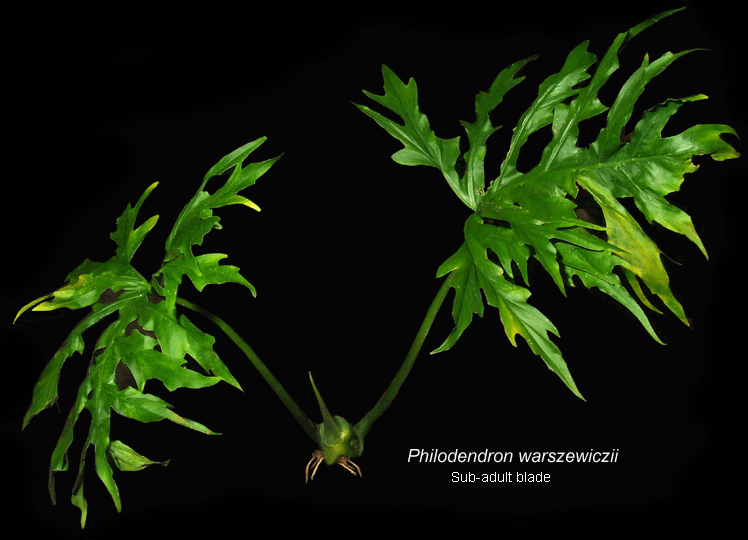
Common names: Guacamayo, Cupapayo, Mano de Lión, Copapayo, Ocopayo,
Papaya de Monte
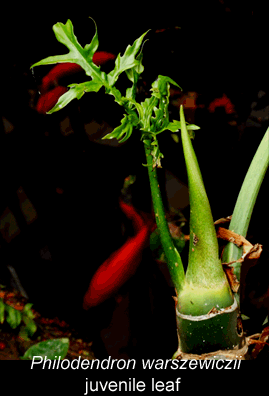 An
exotically shaped Philodendron species, Philodendron
warszewiczii (var-she-VICH-e-eye) from Mexico, near Jalisco to Chiapas in the
southern portion of the country, southward to the country of El Salvador primarily on the Pacific side of Central America.
P. warszewiczii is also found in Honduras and Nicaragua at
elevations of 300 to 1900 meters (980 to 6,250 feet) in tropical dry
rain forest regions. In Mexico, Philodendron warszewiczii is
found principally in Selva Mediana Subperennifolia as well as Selva
Baja Caducifolia. The type specimen of the species was
originally found and published in 1855 and was discovered in Guatemala at an
elevation of 1829 meters (6000 feet). Philodendron warszewiczii
is
known to occur on rocky cliffs and on steep road banks in partial
shade as a terrestrial species.
An
exotically shaped Philodendron species, Philodendron
warszewiczii (var-she-VICH-e-eye) from Mexico, near Jalisco to Chiapas in the
southern portion of the country, southward to the country of El Salvador primarily on the Pacific side of Central America.
P. warszewiczii is also found in Honduras and Nicaragua at
elevations of 300 to 1900 meters (980 to 6,250 feet) in tropical dry
rain forest regions. In Mexico, Philodendron warszewiczii is
found principally in Selva Mediana Subperennifolia as well as Selva
Baja Caducifolia. The type specimen of the species was
originally found and published in 1855 and was discovered in Guatemala at an
elevation of 1829 meters (6000 feet). Philodendron warszewiczii
is
known to occur on rocky cliffs and on steep road banks in partial
shade as a terrestrial species.
A member of Philodendron
section Polytomium, Philodendron warszewiczii is
distinguished by its moderately thin
(subcoriaceous) as well as deeply bipinnatifid (or doubly
pinnatifid) leaf blades. A bipinnatifid leaf has
segments or divisions where the primary divisions are pinnae
(feather-like) as well as having secondary pinnules that are
compound.
The
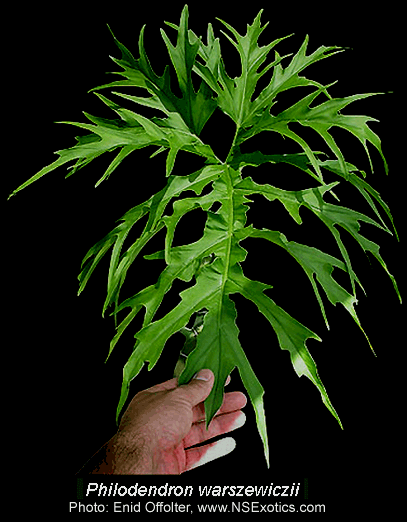 species is often seen leafless during the dry
season. Philodendron warszewiczii is similar to
Philodendron radiatum and also to Philodendron dressleri.
It differs from P. radiatum since it possesses leaf blades
that are both significantly more pinnatified as well as thinner.
The stems of P. warszewiczii are also thicker. Both
species are found in similar forest regions in Mexico. In much of
Central America Philodendron radiatum is found largely in
tropical moist rain forest which is substantially wetter than the
tropical dry rain forest regions where Philodendron warszewiczii
is commonly known to grow.
species is often seen leafless during the dry
season. Philodendron warszewiczii is similar to
Philodendron radiatum and also to Philodendron dressleri.
It differs from P. radiatum since it possesses leaf blades
that are both significantly more pinnatified as well as thinner.
The stems of P. warszewiczii are also thicker. Both
species are found in similar forest regions in Mexico. In much of
Central America Philodendron radiatum is found largely in
tropical moist rain forest which is substantially wetter than the
tropical dry rain forest regions where Philodendron warszewiczii
is commonly known to grow.
Philodendron species,
and especially hybrid forms, are
known to be highly variable and not every leaf of every specimen
will always appear the same. This link explains in greater
detail the scientific principle of natural variation and
morphogenesis.
Click
here.
Found growing terrestrially,
Philodendron warszewiczii frequently grows on rocks. However,
the species is sometimes found as an epiphyte (ep-a-FIT) growing on the sides
of forest trees as an appressed climbing species pressed tight
against the host tree. An appressed climber is one that grows close
to the host. Photos of the species in nature show it growing
in thick clumps quite similar to the fashion landscape gardeners grow
Philodendron
bipinnatifidum (often known as Philodendron selloum) in South
Florida yard landscaping.
The internodes of the Philodendron are short
while the blades are semi-glossy. The cataphylls (the structure
that forms around any new leaf blade) are
thin
and measure 18 to 33cm (7 to 13 inches) in length. The
cataphyll is the singular most important identifying characteristic
of an aroid. Aroid, palm and
cycad expert Leland Miyano had these comments about the species,
"I was looking in Lorenzi's
book on the plants of Burle-Marx and
there is a Philodendron dressleri that looks very similar to
Philodendron warszewiczii. They differ primarily in that P.
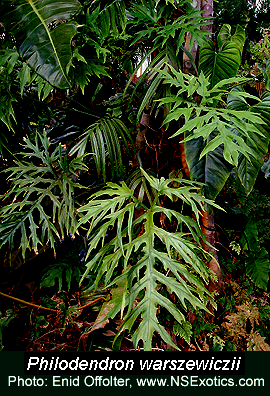 dresslerii does not have as deeply lobed leaves and the photo seems
to indicate that it is more prone to climbing." In a seperate
email Lelandy continued, "My plants just ramble on the ground at
the moment...but perhaps it will climb. I think that mine are
seeking out the perfect light for itself...they prefer bright
filtered light. Deep shade really slows them up. My plants are of
moderate growth rate...easily grown from cuttings. I have had mine
for years but they just crawl about until it crosses a path and I
cut it. In general I'd say it is like a serpent Philodendron,
snaking along the ground. But that is in my growing
conditions...every garden is different."
It is
not uncommon for Philodendron warszewiczii to completely
loose its leaves during the dry season and become deciduous. The
petioles that support the leaf blade typically measure 33 to 58cm
(13 to 23 inches) in length but may be as long as 80cm (31.5 inches)
long. The petioles are subterete to "C" shaped.
Subterete is considered just less than cylindrical.
dresslerii does not have as deeply lobed leaves and the photo seems
to indicate that it is more prone to climbing." In a seperate
email Lelandy continued, "My plants just ramble on the ground at
the moment...but perhaps it will climb. I think that mine are
seeking out the perfect light for itself...they prefer bright
filtered light. Deep shade really slows them up. My plants are of
moderate growth rate...easily grown from cuttings. I have had mine
for years but they just crawl about until it crosses a path and I
cut it. In general I'd say it is like a serpent Philodendron,
snaking along the ground. But that is in my growing
conditions...every garden is different."
It is
not uncommon for Philodendron warszewiczii to completely
loose its leaves during the dry season and become deciduous. The
petioles that support the leaf blade typically measure 33 to 58cm
(13 to 23 inches) in length but may be as long as 80cm (31.5 inches)
long. The petioles are subterete to "C" shaped.
Subterete is considered just less than cylindrical.
The leaf blades of P. warszewiczii are sagittate, or triangular in their outline. Sagittate is the botanical term which describes any leaf that is "arrow shaped". The blades are deeply bipinnatisect. Bipinnatisect is defined as a leaflet which is divided into pinnae. The term "pinnae" indicates the leaf blade is somewhat similar to a feather or multiply divided like a palm frond. The deep divisions come to within 1 to 4cm (.4 to 1.6 inches) of the midrib and are thin, semi-glossy and slightly bicolorous (multicolored). Adult blades can measure from 31 to 78cm (21.2 to 30.7 inches) in length as well as 30 to 62cm (12 to 24.2 inches) wide. The blade's adaxial (upper) surface is only moderately glossy. Only minor leaf veins are visible.
 Philodendron
warszewiczii is capable of producing from one to
three inflorescences per axil. On any aroid, the inflorescence is the
reproductive portion of the plant that is often referred to as a
"flower". In reality, a spathe is simply a modified
leaf
appearing to be
a hood
. The spathe and spadix together comprise the inflorescence
which is supported by the peduncle. A peduncle is the internode
between the spathe and the last foliage leaf. The peduncle may be as short
as 2.5cm (1 inch) but is typically 4.5cm to as long as 16cm (1.75 to
6.25 inches) in length and is dark green in color.
Typically the spathe measures approximately 14cm to as long as 30cm (5.5
inches to 12 inches). The interior of the spathe is pale green
to white. The spadix which
is seen at the center of the inflorescence is white and measures 14 to 24cm
(5.5 inches to 9.4 inches) long but may be as long as 30cm (12 inches).
The berries produced on the spadix, once fertilized, are white to pale
yellow in color and are oblong to ellipsoid in shape. Flowering appears
to be somewhat rare in nature and berries are more commonly produced near
the beginning of the dry season.
Philodendron
warszewiczii is capable of producing from one to
three inflorescences per axil. On any aroid, the inflorescence is the
reproductive portion of the plant that is often referred to as a
"flower". In reality, a spathe is simply a modified
leaf
appearing to be
a hood
. The spathe and spadix together comprise the inflorescence
which is supported by the peduncle. A peduncle is the internode
between the spathe and the last foliage leaf. The peduncle may be as short
as 2.5cm (1 inch) but is typically 4.5cm to as long as 16cm (1.75 to
6.25 inches) in length and is dark green in color.
Typically the spathe measures approximately 14cm to as long as 30cm (5.5
inches to 12 inches). The interior of the spathe is pale green
to white. The spadix which
is seen at the center of the inflorescence is white and measures 14 to 24cm
(5.5 inches to 9.4 inches) long but may be as long as 30cm (12 inches).
The berries produced on the spadix, once fertilized, are white to pale
yellow in color and are oblong to ellipsoid in shape. Flowering appears
to be somewhat rare in nature and berries are more commonly produced near
the beginning of the dry season.
Our specimen was a gift from
collector Christopher Mink who lives on the west coast of Florida. In one email
note
Christopher made these comments regarding Philodendron
warszewiczii, "Some
people say that P. warscewiczii is a self-header and does not
climb. This is not true- it climbs really fast. I rooted a huge 6'
x 4" cutting in June and it has grown about 6" of new trunk, 5 new
leaves and made about 6 blooms since. I also cut 2 feet of the end
of the trunk before I planted it so I could have two plants. Very
shortly after planting them both, the large cutting rooted right to
the tree and bloomed. The 2' section rooted
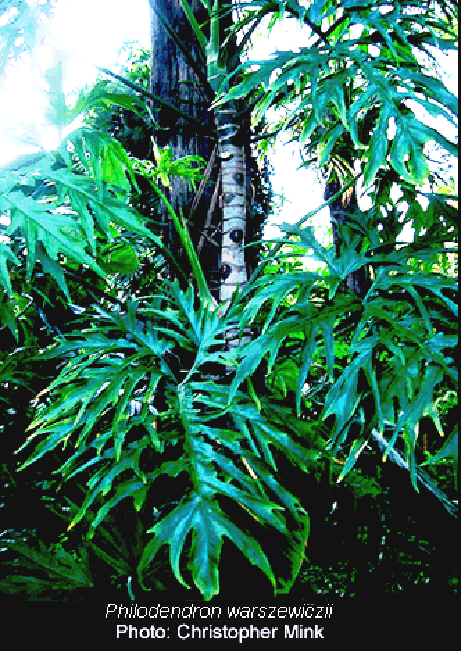 and produced three
pups. This will be one of your favorites!" We
grow Philodendron warszewiczii as a terrestrial
plant with our specimen planted in very loose soil which contains
near equal percentages of rich soil, peat moss, Perlite, and orchid
potting media containing bark, charcoal, and gravel. The specimen
is grown in bright shade.
and produced three
pups. This will be one of your favorites!" We
grow Philodendron warszewiczii as a terrestrial
plant with our specimen planted in very loose soil which contains
near equal percentages of rich soil, peat moss, Perlite, and orchid
potting media containing bark, charcoal, and gravel. The specimen
is grown in bright shade.
My thanks to Enid Offolter of Natural Selections Exotics in Fort Lauderdale, FL , Leland Miyano in Hawaii and Christopher Mink for the use of their photographs. Leland's photo was taken at the Kampong in Miami, FL which is a part of Fairchild Tropical Botanic Garden. The specimen at the top of the page is in our collection and has not completely reached maturity.
All
information for this description was extracted from Dr. Tom Croat's
A Revision of Philodendron Subgenus Philodendron (Araceae) for Mexico
and Central America, Annals of the Missouri Botanical Garden,
Vol. 84, No. 3. (1997), pp. 311-704.
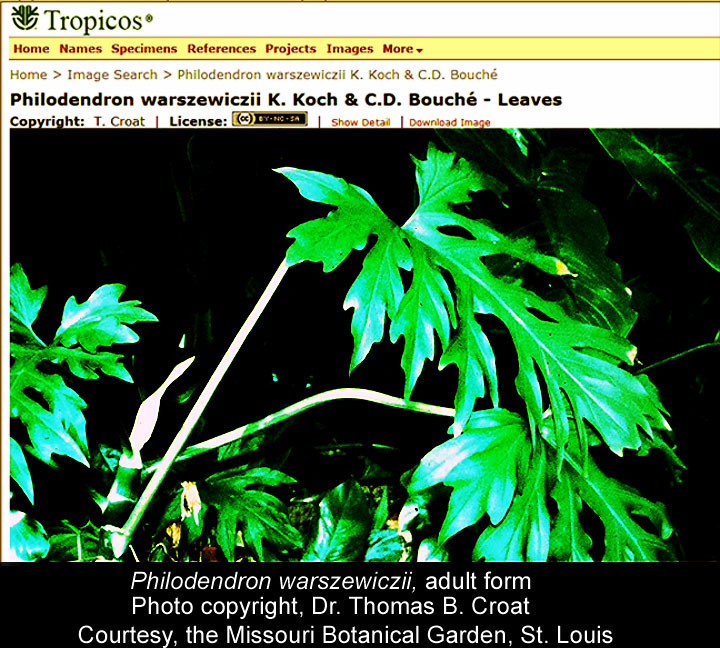
Aroid Pollination!
As
it occurs in nature and by any horticulturist
Looking for a specimen? Contact
 The
finest aroids in Ecuador available direct to any collector!
The
finest aroids in Ecuador available direct to any collector!
http://www.ecuagenera.com//Tropical Plants/Araceae
![]()
If you are seeking information on other rare species, click on "Aroids and other genera in the Collection" at the top and look for the
Want to learn more
about aroids?
Join the
International Aroid Society:
http://www.exoticrainforest.com/Join%20IAS.html